

Key Challenges and Opportunities
as Ontario Moves Ahead in the New Millennium
A Message from the President
As we approach the new millennium, Premier Harris
has challenged all of us to think about our economic future.
He is optimistic about the economic future of
our communities, our regions and our province in this changing global environment.
We have the talent, the resources and the power to decide what kind of
future we want. Together we can develop the strategies and the actions
to get us there.
To meet the challenges of the global marketplace,
and to seize the opportunities before us we need a road map. A road map
developed together, beginning with a shared vision of making Ontario the
best jurisdiction in North America to live, work and raise a family.
As Ontarians, we need not approach this challenge
with fear. We should have a strong sense of confidence and optimism. Our
economic and fiscal problems of the recent past are now being addressed
and the results are clear. The provincial deficit is coming down. We are
on track to balancing our budget by fiscal year 2000-2001. Personal income
taxes, which used to be among the highest in North America, are now among
the lowest in Canada. Job creation has reached historic levels. Over 370,000
net new private sector jobs have been created since June of 1995.
However, the work to date has not won us the race.
We must continue to build a strong and growing economy. We must continue
to create more jobs and prosperity. We are in a race that does not have
a finish line. Our competitors next door, and around the world, are not
standing still. All of the provinces and states around us are continuing
to improve their business and investment climate.
If we wish to keep the quality jobs we now have
and stimulate new growth and investment in Ontario, we must continue to
improve our business climate at both the community and provincial level.
We must continue to innovate and to sharpen our competitive edge. In the
race for quality jobs and investment, our goal is to get out in front and
stay there.
That is why the Premier has asked us to embark
on this challenge. As individuals, businesses, communities and organizations
from all sectors and regions of our province, we must consider the future.
We must plan for the new economy. We must ensure our future growth and
prosperity so we can maintain and enhance the quality of life for all Ontarians.
It is only through increased jobs and prosperity that we will be able to
continue to develop and finance the social programs and quality of life
we all expect in our caring and compassionate society.
Ontario is one of the most export-oriented and
advanced economies of the world. That is one of our strengths, but it also
poses a challenge. We must recognize our need to remain globally competitive
across the diverse sectors and regions of our economy. We cannot rely on
a low Canadian dollar for our long-term competitive advantage. We must
continually strive to improve quality and efficiency. In that way, we will
keep the quality jobs that already exist in Ontario and attract new investment
to our province.
In the new global environment, we must recognize
that our capital - both financial and human - can migrate quickly. The
critical challenge Ontario faces is to differentiate itself. That is, to
rise above the crowd by creating an environment where good things are happening,
where entrepreneurs and business people can grow and succeed, and where
people want to live and work.
To help us develop a road map for Ontario's economic
future, Premier Harris created the Ontario Jobs and Investment Board. As
Chair of the Board, the Premier has asked us to develop an action-oriented
economic vision and plan for the next century.
To assist the Board in its work, three special
advisory panels have been created. Each panel will explore distinct ways
to build an economic vision and plan that will guide us into the new millennium.
The Board asked the panels to consider Ontario's
economic strengths and weaknesses, as well as its opportunities and threats,
and to seek the input of individuals and organizations across the province.
This discussion paper has been prepared by the
Special Advisory Panel on Creating an Innovation Culture to support the
Premier's Conferences on Jobs and Prosperity. These conferences will be
held in regions across Ontario in the fall of 1998.
Regardless of whether you can attend one of these
conferences, the Jobs and Investment Board welcomes your input and advice.
Together, we will build an economic plan to prepare Ontario for the new
millennium.
On behalf of the Board and our Special Advisory
Panels, we look forward to hearing from you.
Sincerely,
David Lindsay
President and CEO
Ontario Jobs and Investment Board
INTRODUCTION
The Ontario Jobs and Investment Board has asked the Special Advisory
Panel on Creating an Innovation Culture to consider the challenges Ontario
faces in creating a culture of innovation in Ontario.
The Creating an Innovation Culture in Ontario paper is one of three
discussion papers prepared by Special Advisory Panels. The panels were
established to provide advice to the Board as it spearheads the development
of a long-term economic strategy and vision for Ontario in the new millennium.
The other two discussion papers address:
-
Creating Infrastructure for Growth and Competitiveness, and
-
Preparing People for Tomorrow's Jobs.
In developing this paper, the panel has focused on the key challenges and
issues Ontarians face in building a culture that encourages and rewards
innovation throughout the economy. Our aim is to stimulate ideas and discussion
and provide useful supporting information for the Premier's Conferences
on Jobs and Prosperity.
The Panel members are:
-
Bill Buxton, Chief Scientist, Alias/Wavefront Inc. (Chair);
-
Bryne Purchase, President of SAGES Inc., and
-
Kenneth Knox, Deputy Minister, Ministry of Energy, Science and Technology.
We want to hear your views. To help you, we have
provided key challenges and questions that are summarized at the end of
the Paper. You can get in touch with us by writing to:
The Special Advisory Panel on
Creating an Innovation Culture
Ontario Jobs and Investment Board
Suite 4340, Whitney Block
99 Wellesley Street West
Toronto ON M7A 1A1
ONTARIO'S QUALITY OF
LIFE DEPENDS ON INNOVATION
Rapid economic and technological change has defined the 20th century.
Global progress has led to some social upheavals but, on the whole, has
improved the quality of life for most citizens. Many people expect that
the 21st century will witness an even faster pace of change. In Ontario,
our key challenge - collectively and individually - is not merely to adapt
to change but to anticipate it and take steps ahead of time to make the
most of it. Underlying what follows is a belief that by following our current
path, Ontario will - at best - maintain its position. In order to improve,
it will take change to innovate - to break stride.
This discussion paper is, therefore, about innovation. Innovation can
be defined in many ways depending on your perspective - student, entrepreneur,
researcher, designer, inventor, artist, teacher, self-employed or employee.
But, put simply, it is the ability to both generate and take advantage
of new ideas and new ways of doing things. The end result is improved competitive
advantage.
It could be argued that our ability to innovate depends largely on two
factors:
-
The people, organizations and institutions in our society and
-
Our system of values and incentives and the ways they guide our behaviour,
collectively and individually.
It is, therefore, an issue of culture.
Innovation can make major contributions to our quality of life.
Consider:
-
The most wealthy nations and regions of the world are the most innovative;
-
Most new jobs depend on innovation;
-
Innovation is a renewable source of wealth, and The status quo is not
a viable option.
The most wealthy nations and regions
of the world are the most innovative.
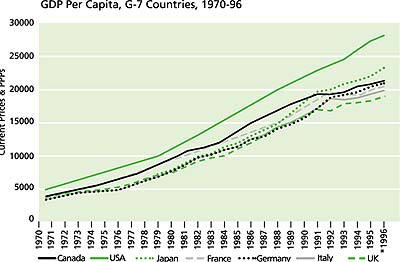
Source OECD
*OECD estimate
(Current Prices and Purchase Price
Parity (PPP), US Dollars)
PPP is the exchange rate between two countries
that equalizes the purchasing power of two currencies for a similar basket
of goods and services in each country.
In the 19th century Great Britain was arguably the most innovative society
in the world. It was also the wealthiest and its currency the strongest.
The same could be said of the United States today. Canada and other nations
are meeting with various levels of success as they try to catch up.
Chart 1 shows Gross Domestic Product Per Capita in the seven leading
industrialized countries. GDP, a standard measure of economic strength,
refers to a country's total output of goods and services. Notice that the
United States (U.S.) is well ahead, and that the gap is growing between
it and the other G-7 countries. Canada consistently held onto second place
from the mid-1970's to the beginning of the 1990's but Canada, like the
other nations, is falling more and more behind the U.S.
Most new jobs depend on innovation
Chart 2 indicates that although high-tech, knowledge-intensive industries
account for 39% of overall employment in Ontario, they generate more than
two-thirds of new jobs in the province. 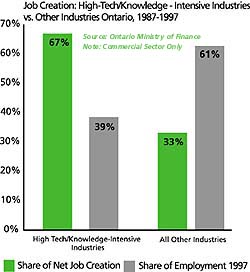
Innovation is a renewable source
of wealth.
Innovation can lead to huge improvements in countless forms of human
activity, such as:
-
the buildings we inhabit;
-
the machines we use;
-
the ways we treat human illness;
-
the computer programs we rely upon;
-
the ways we learn, teach and communicate, and
-
the ways we organize society.
By their very nature, human ideas are unlimited, and are therefore renewable
sources of wealth. Traditionally, natural resources were a key factor in
determining a nation's economic wealth. But as ideas have become more and
more crucial in modern times, even nations with limited natural resources
can become global economic leaders - as long as they can generate and apply
new ideas.
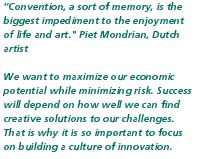 The
status quo is not a viable option
The
status quo is not a viable option
Maintaining the status quo or convention merely sustains the position
of Ontario, at best.
Ontarians should be working harder to achieve new and distinct advantages
over our economic competitors. This requires strength and leadership, and
involves risk. But the rewards can be considerable. This document is a
call to action.
WHAT IS INNOVATION?
As we indicated earlier, innovation is about ideas. Ideas and processes
only advance change where the culture of that society accepts the change.
It is about a willingness to look ahead and think about longer-term opportunities
and threats.
For the purposes of this discussion, innovation can be seen in even
broader terms. Innovation:
-
refers to our ability to generate and adapt to change;
-
applies to all human activities;
-
involves risks, and
-
requires collaboration.
Innovation may apply to all human activities.
Human thought and ingenuity affects every sphere of life. Innovation
influences, for example:
-
agriculture;
-
biology;

-
health care;
-
education;
-
transportation;
-
environmental protection;
-
sports;
-
arts and entertainment, and
-
political institutions.
Innovation spreads to all types of business activities, including:
-
management and organization;
-
finance;
-
marketing and customer service;
-
design;
-
product development;
-
research, and
-
manufacturing.
One of the most important business innovations has been the development
of the modern limited liability corporation. It has allowed for large-scale
risk taking in the private sector.
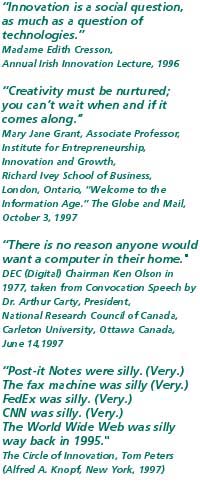 Innovation
runs across all economic sectors, and affects communities of all sizes.
Traditional sectors such as agriculture, mining and forestry are hugely
innovative. Service businesses and sectors such as financial institutions
and the entertainment industry are increasingly large investors in innovative
approaches to meeting customer needs.
Innovation
runs across all economic sectors, and affects communities of all sizes.
Traditional sectors such as agriculture, mining and forestry are hugely
innovative. Service businesses and sectors such as financial institutions
and the entertainment industry are increasingly large investors in innovative
approaches to meeting customer needs.
Innovation in political institutions has been fundamental to the growth
of Western democracies. For example, innovation has spilled over into ways
governments offer education, policing and consumer protection through regulations.
Innovation means generating and
adapting to change
First one invents, then one innovates. One may invent or discover a
new product or a new way of doing things. But, from a social perspective,
innovation occurs only when this new product or process becomes widely
used.
In the commercial world, the innovative product or process becomes successful
when consumers use it widely such as the cell phone. Consider another example
taken from the world of track and field. In the high jump, a new, back-first
technique known as the "Fosbury flop" became widely imitated and led to
new world records.
Innovation by its very nature involves improvements over traditional
products or techniques. Sooner or later, these improvements come to be
widely appreciated. Personal computers, now a frequent home and office
feature, have existed since the early 1980's.
Innovations not only create new products, processes and institutions,
but also destroy the status quo. The very role of innovation is to change
or replace traditional ways of doing things. That is why innovation tends
to face certain barriers, such as:
-
lack of public knowledge;
-
reluctance to accept change;
-
concerns about the cost of change, and
-
opposition by those who prefer the status quo.
Innovation is inherently risky.
 To
innovate, one must step beyond what is known and accepted by society. That
is why it involves risks.
To
innovate, one must step beyond what is known and accepted by society. That
is why it involves risks.
-
Efforts to invent may fail or come to nothing. The experimental drug, for
example, may prove under trial to have no therapeutic effect.
-
Efforts to win public approval and commercial success may fail. For example,
the public has been reluctant to accept irradiated foods.
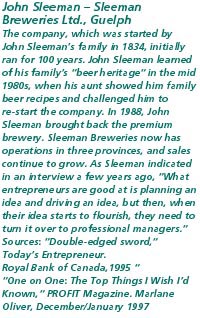 The
pay-off to a successful innovation can be very great. From time to time,
a successful innovator becomes extraordinarily wealthy. The story of Microsoft
and Bill Gates is the most spectacular in business today. Innovators in
all fields have the potential to earn great fame and fortunes. But the
pay-off for a successful innovation need not always be in the form of financial
reward. There are also personal rewards as well as professional and community
recognition and approval. The broader society and individual communities
can also benefit from innovation spinoffs such as job creation and new
investment.
The
pay-off to a successful innovation can be very great. From time to time,
a successful innovator becomes extraordinarily wealthy. The story of Microsoft
and Bill Gates is the most spectacular in business today. Innovators in
all fields have the potential to earn great fame and fortunes. But the
pay-off for a successful innovation need not always be in the form of financial
reward. There are also personal rewards as well as professional and community
recognition and approval. The broader society and individual communities
can also benefit from innovation spinoffs such as job creation and new
investment.
However, unsuccessful efforts to innovate can be costly. A modern corporation
can lose millions of dollars if it fails after trying to pioneer a new
product. Also at stake are the possible losses of face, friends, reputation
and future opportunity.
Innovation involves collaboration.
Innovation is typically made possible by entrepreneurs who build teams
with experts in areas such as invention, technique, business and finance.
There are countless examples of successful entrepreneurs who use their
resources and commercial abilities to team up with "smaller players" with
great ideas.
WHAT ENCOURAGES INNOVATION?
Consider:
What are the incentives to innovate?
What obstacles stand in the way of achieving a culture of innovation?
An Innovation System
Innovation depends on:
-
human capital (people and skills);
-
organizational and physical infrastructure (corporations, schools, universities,
colleges, and governments, communications systems, etc.);
-
financial infrastructure (banks, investors and other sources of capital);
-
legal infrastructure and civil justice system (intellectual property laws),
and
-
social or community capital (relationships between people and between organizations).
Innovation also rests on our culture - the values, rules, customs and incentives
that govern the way we work and the way our institutions function.
In the world of innovation, culture comes down to shared attitudes,
values and beliefs. It determines how well we encourage creativity, risk-taking,
entrepreneurship, and networks to share knowledge and ideas.
Culture is reflected in our behaviour, such as how we set and pursue
priorities. Culture also refers to how we organize ourselves and relate
to other organizations. Culture exists at many levels - corporate or service
organization, sector, community, region, province or country.
Human Capital
Consider:
Creating an innovation culture is a long-term and dynamic process.
How do we shape and change the ways of thinking and interacting of our
youth - our future innovators?
How do we respect, build, encourage, support and reward innovation?
By world standards, Ontarians are well educated. Ontario has a higher
rate of post-secondary educational achievement than any country in the
Organization for Economic Cooperation and Development (OECD).
In 1997, 46% of Ontario adults aged 25 years and over had completed
post-secondary education.
Skilled labour is the biggest reason why foreign-controlled multinationals
(FCMNs) perform R&D in Canada, according to a survey conducted for
a 1996 report on Canada's R&D position. In addition, many FCMN parent
firms have internal studies demonstrating that the cost to perform R&D
in Canada is between 20% and 40% less than in areas in the United States.
The cost advantage comes from lower salary costs, the Canada-US exchange
rate and a variety of direct and indirect government support programs including,
for example, generous R&D tax incentives.
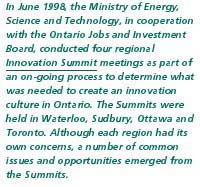 Despite
these advantages, there are concerns. Slower labour force growth and an
aging workforce means that we will have to meet new needs for skilled labour
by retraining current workers. The Special Advisory Panel on Preparing
People for Tomorrow's Jobs raises the implications of these trends in its
companion discussion paper. These trends will affect training, re-training
and adjustment policies in the private and public sector.
Despite
these advantages, there are concerns. Slower labour force growth and an
aging workforce means that we will have to meet new needs for skilled labour
by retraining current workers. The Special Advisory Panel on Preparing
People for Tomorrow's Jobs raises the implications of these trends in its
companion discussion paper. These trends will affect training, re-training
and adjustment policies in the private and public sector.
The Preparing People for Tomorrow's Jobs Panel, also considers the implications
for a growing number of self-employed people. If the movement towards self-employment
turns out to be a long-term trend, it could affect the intensity of innovation
by individuals and organizations.
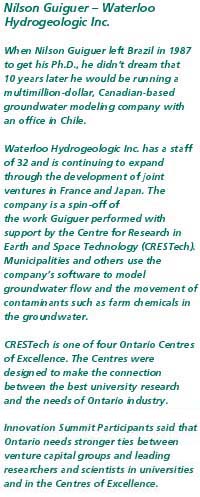 Organizational
and Physical Infrastructure
Organizational
and Physical Infrastructure
Consider:
Do we have the right infrastructure in and among our schools, universities,
colleges, laboratories, firms and communities?
Are they well linked through relationships, partnerships, alliances
and networks?
What can we do to help Ontario companies outperform their competitors?
How can Ontario's innovators connect better with venture capitalists,
management and marketing consultants, business associations and research
universities?
Ontario has many major research organizations
and universities and colleges, including some of the best in the world.
Among 46 institutions, there are:
Some of Ontario's leading research institutes include:
-
the National Research Council, and
-
Ontario's four Centres
of Excellence: the Centre for Research in Earth
and Space Technology (CRESTech), Communications and Information Technology
Ontario (CITO), Materials and Manufacturing Ontario (MMO), and Photonics
Research Ontario (PRO).
Successful firms invest more in "soft" assets such as R&D and intellectual
capital. Among the world's 200 largest R&D performers, the only Ontario-based
company is Nortel. Ranking 28th on the list, Nortel is a highly successful
world-class innovator, and a huge R&D performer. The emergence of more
powerhouses such as Nortel would have a significant impact on Ontario's
economic growth potential.
Successful countries generally invest more in
research and development than others do.
According to the Organization for Economic Cooperation
and Development:
-
$13.1 billion, or 1.66% of Canada's GDP, goes to
R&D (1996).
According to Statistics Canada data:
-
$6.5 billion, or 2.1% of Ontario's GDP, goes to R&D
(1995).
The Conference Board of Canada notes that technology has a decisive impact
on economic productivity and performance. But the Board goes on to say
that small and medium-sized enterprises in Canada appear to be weaker at
adopting new technology than their U.S. counterparts. Take for example:
-
half of Canadian firms with 20 to 99 employees use at least one advanced
technology
-
67% of U.S. companies of the same size use at least one advanced technology.
To complicate matters, Canadian companies tend to use relatively less expensive
and less productive technologies than their American counterparts.
Within Canada, Ontario leads the way in the use of new technology. Ontario
manufacturers tend to adopt technology and use it in more complex ways
than their counterparts in other provinces.
Ontario has become a hot spot for thousands of relatively small but
fast-growing, innovative firms that could become tomorrow's corporate giants.
These so-called Innovative Growth Firms create valuable jobs and keep Ontario
on the cutting edge of new technologies. And they:
-
force competitors to become more innovative;
-
stimulate customers and suppliers to upgrade;
-
penetrate foreign markets and pave the way for other firms, and
-
are positioned to show corporate leadership and to improve overall, sector-wide
business prospects.
To appreciate the significance of these innovative growth firms, picture
not only what they are doing today but also what they could become tomorrow.
Consider examples of Ontario-based companies that used to be small not
very long ago:
-
COM DEV International;
-
Newbridge Networks Corporation;
-
Royal Group Technologies Ltd., and
-
Magna International Inc.
Innovative firms learn from each other. The Innovators Alliance is a new
initiative created by the Ontario government and the private sector to
accelerate the growth of innovative growth firms in Ontario. The Alliance
helps firms connect with each other and with business service providers.
This helps them address common issues and explore new business opportunities.
Too few of Ontario's promising innovative companies manage to make the
transition to medium size and then go on to become large, global players.
Compared to American competitors such as California, Ohio, Michigan, Pennsylvania
and Massachusetts, Ontario has a smaller share of firms in the mid-size
(100-499 employees) and large size (500 plus) categories.
Legal and Financial Infrastructure
Consider:
What improvements do we need to make to access to financing and our
system for protecting intellectual property to encourage and support innovation?
The ways that we reward risk affect our capacity to innovate. For example,
knowledge is a unique type of commodity, what economists would call a pure
public good. Any number of others can easily acquire and reuse the ideas.
As a result, the creators may not get a full pay-off from their original
creation. This can discourage new investments and new products. To ward
off this problem, inventors and entrepreneurs can apply for patents and
trademarks to protect their products from imitation.
However, giving a company the sole right to produce a specific good
can also inhibit the benefits to society gained from open and widespread
access to knowledge. That is why patents, for example, are temporary.
 Our
international and national system of protecting intellectual property remains
far from perfect, and has sparked frequent debate. "Innovations" related
to our intellectual property laws and legal system need to keep pace with
changes throughout the economy.
Our
international and national system of protecting intellectual property remains
far from perfect, and has sparked frequent debate. "Innovations" related
to our intellectual property laws and legal system need to keep pace with
changes throughout the economy.
Access to financial capital is key to innovation. The tax system, also,
can have a positive impact. Ontario's tax incentives for R&D are among
the most generous in the world. However, our R&D tax credits are largely
directed at only one part of the innovation process. They may not provide
incentives for many other innovative activities that can generate wealth.
Small business groups have recommended various ways to improve access
to capital and encourage innovation:
-
create an environment that encourages more financial institutions and other
private sector sources to lend money to small business;
-
encourage new private sources, and more financial institutions, to lend
to and invest in small businesses;
-
reduce regulatory barriers and the costs they create for small business,
and
-
continue to cut taxes.
Community and Social Capital
1) Communities, Networks and Risk Reduction
Consider:
Where in Ontario are innovative attitudes and values apparent? What
can we learn from them?
Industries tend to cluster in certain geographic locations. Clustering
helps companies reduce risks by creating communities of workers and suppliers
that meet their needs.
When it comes to financing ideas, lenders tend to be hesitant because
they have few hard assets to seize in case of a business failure. Clustered
economic activity allows people and organizations to develop track records
that become well known to others in the community. These track records
are critical to one's ability to attract the financing necessary to develop
new intellectual properties. Clustering can also give employees, as well
as those who are self-employed or entrepreneurs, some security in their
job or work choices; for example, the option to move to another company
or employer is enhanced when you have developed a track record within that
cluster of companies. Good track records help entrepreneurs and innovators
overcome these barriers.
The concentration of business activity in a certain geographic area
attracts new competitors and suppliers. Ottawa's Silicon Valley North is
populated with firms tracing their heritage back to Bell Northern Research
and Computing Devices, just as a new generation of companies have spun
out from Newbridge Networks. Another example includes a cluster of digital
media companies that have located or spun out of the Toronto area (Kitchener/Waterloo
and Ottawa also have pockets of digital media activity). The estimated
400 interactive digital media companies operating in the province already
employ about 8,000 people and have significant potential for growth.
Communities, both large and small, can take advantage of sound economic
environments at the provincial and national level to shape their own economic
destinies. Community development is a bottom-up process, which requires
that individuals and organizations come together to focus on the future
and to provide the leadership needed to chart a road map for the future.
Successful communities assess their strengths and weaknesses, make the
most of opportunities, and confront challenges. They identify the actions
and capabilities required to meet their job creation and development potential.
Much attention has gone to communities that have bred manufacturing
and high-tech clusters. But communities can also excel at their own forms
of innovative economic development.
-
Cobourg has used its historic buildings and lakefront to attract film and
television production;
-
Elora has become a popular tourist destination by offering a historic setting,
the natural beauty of the Elora Gorge and Elora Mill, and the entertainment
of the Elora Festival;
-
Niagara-on-the-Lake and surrounding communities have built on their natural
and commercial strengths to develop an area known for wineries, fine dining,
historic landmarks, parks, and entertainment;
-
Sault Ste. Marie's gateway project is looking to build on it's international
border crossing location to attract new tourism investment, and
-
Kitchener-Waterloo hosts North America's largest Bavarian festival in a
nine day celebration of Oktoberfest.
 Geographic
clustering can improve competitiveness and innovation. Even physically
isolated companies and communities can benefit, thanks to increasingly
sophisticated technology and telecommunications. Every day, companies in
remote and aboriginal communities are finding themselves less remote -
and more able to participate in the knowledge-based economy. Doing business
electronically has become very widespread, touching virtually all sectors
ranging from bank services and food service operators to booksellers.
Geographic
clustering can improve competitiveness and innovation. Even physically
isolated companies and communities can benefit, thanks to increasingly
sophisticated technology and telecommunications. Every day, companies in
remote and aboriginal communities are finding themselves less remote -
and more able to participate in the knowledge-based economy. Doing business
electronically has become very widespread, touching virtually all sectors
ranging from bank services and food service operators to booksellers.
2) Innovation and the Renaissance Community
Consider:
How can cooperation and collaboration within and among organizations
be encouraged and strengthened to create an innovation "infrastructure"?
Innovation works best when people with different knowledge, skills and
perspectives are brought together to tackle challenges. These "renaissance"
teams can be created within organizations, firms and in geographic communities.
Highly functional networks in communities also benefit from the interaction
of various skills. For example, bringing a new invention to market requires:
-
creative thought;
-
scientific ability;
-
financial skills;
-
marketing work, and
-
customer acceptance.
This combination of business skills is what panel member Bill Buxton calls
the New Multiculturalism.
Of course, the importance of networks in the geographically based community
extends beyond individuals to organizations, both public and private. For
example, it is well-documented that "innovative communities" foster close
ties between universities, colleges and private sector research organizations

Similarly, private companies sometimes develop collaborative linkages
or networks.

Culture
1) Necessity Is the Mother of Invention:
Cultures Are Products of the Environment
Consider:
How do we create an environment at the firm, organization and community
levels that rewards those who take risks and those who look for new and
more effective ways of doing things?
 Innovation
results from thought followed by action.
Innovation
results from thought followed by action.
It depends in part on the personal abilities of the leading innovator.
But innovation is also affected by the environment - where we live and
work.
Culture reinforces the behavior and strategies we require to succeed
in any given environment. But environment dictates culture, too. If we
live in a business environment that favours innovation, then such behaviour
will become prevalent. There is an old saying, which goes: "Necessity is
the mother of invention." The more demanding the environment in certain
respects, the more likely the organization or individual is to respond
innovatively.
Examples abound in Ontario and Canada. The difficulties associated with
finding, extracting, processing and transporting Ontario's natural resources
spurred high levels of invention in the resource sector. As the following
examples show, there is evidence that tough environmental regulations can
stimulate innovative solutions.
Competition creates a demanding environment. Knowledgeable customers
armed with a choice of suppliers tend to force companies to innovate. Each
competitive environment tends to foster its own type of innovation culture.
For example, one would expect to find different corporate cultures in moving
from a logging company to a software firm.
By contrast, companies that enjoy monopolies - the right to be the sole
supplier of a given good or service - have few built-in incentives to innovate.
Recognition
of this fact has led to ending certain monopolies, which in turn has
resulted in increases in productivity, performance and improvements in
service to customers.
2) Cultures Are Deeply Embedded In the
Social Infrastructure
Consider:
Can we create a culture in Ontario that views innovation, entrepreneurship
and risk-taking with the same spirit, curiosity and enthusiasm found in
our hockey system?
Canadian hockey is an example of how various elements of a system come
together for our collective benefit. It is highly unlikely that any given
child will make it to the National Hockey League (NHL). And many risks
are involved in making the effort. Nevertheless, millions of Canadians
- children and parents - buy into the dream of a professional hockey career.
Why?
-
they believe in the dream;
-
they share the dream, and
-
a highly effective system supports the pursuit of the dream.
The hockey development system selects and nurtures young talent. Individual
skills and attitudes are extensively documented. The ultimate prize is
clear - a handsome contract and the recognition of playing in the NHL.
The system is fully supported by the broader community made up of local,
provincial and national organizations and associations. It is embedded
in our culture. Hundreds of thousands of players are involved and success
requires near total dedication to the goal.
Our hockey system mirrors many of the requirements of innovation:
-
It is a high-risk endeavour;

-
It involves many people with different skills;
-
Its values are internalized by people at a very young age;
-
Individual track records count for a great deal;
-
It enjoys major support from the community, and
-
It actually becomes part of the fabric of our culture.
A CALL TO ACTION
Consider:
How will we know that Ontario is getting better at creating a culture
of innovation?
What are the current indicators for measuring our performance and
activities? Are they the right indicators?
What is the role of government in helping to build an innovation
culture and economic environment? How can the different levels of government
work better together to stimulate innovation?
What can we learn from other jurisdictions?
Ontario accounts for 41% of Canada's gross domestic product. It is Canada's
industrial heartland, and its most diversified economy. Ontario is a major
trading jurisdiction, and depends heavily on international trade and investment.
The Ontario Government has focused on the quality of our business environment
by taking various steps:
-
tax reductions;
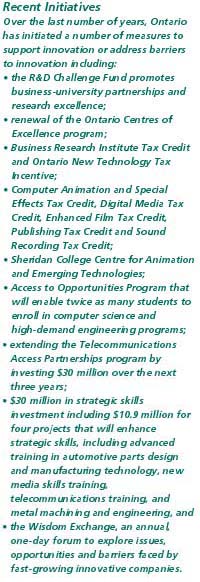
-
moving clearly toward balancing the budget, and
-
eliminating red tape and needless regulations.
Ontario's fundamentals are sound and provide a positive environment for
future growth:
-
strong job creation;
-
sustained GDP growth;
-
low interest rates;
-
low inflation;
-
increased consumer spending;
-
more business confidence;
-
more demand for housing, and
-
increased exports.
We have to recognize and respond to areas of weakness. For example, the
World Competitiveness Yearbook gives Canada poor marks in certain key areas,
including: science education, overall productivity growth and entrepreneurship.
Ontarians still face many economic challenges.
-
our export success is in part due to the weak Canadian dollar, and
-
our R&D, while the best in Canada, still lags behind competitors such
as Michigan, Massachusetts, Pennsylvania and California.
We need to identify and deal with impediments to innovation, including:
-
lack of skilled workers;
-
lack of information on, and access to, technologies;
-
lack of information on markets;
-
lack of technology assessment and business supportservices;
-
barriers to inter-firm cooperation;
-
barriers to business, labour and government cooperation;
-
barriers to university/college and business cooperation;
-
lack of access to financing, and
-
lack of a corporate or community culture that values innovation.
A More Demanding Environment
The global economy continues to become an ever more competitive and
demanding environment. Trade liberalization increases the number of global
competitors for products and the number of countries competing for foreign
direct investment. The increasingly competitive international market for
scientists, engineers and
computer animators, just to name a few examples, is giving rise to concerns
about the "brain drain" and its long-term consequences. In some sectors,
investment tends to follow top scientists and researchers or skilled workers
- which makes it harder for us to attract and keep them.
Worldwide, consumer expectations are increasing, as they demand more
sophisticated and customized products and services. New technologies are
shortening product life cycles and forcing companies to respond faster.
Companies must have the capacity to quickly apply new technologies. Companies
will also be challenged to keep abreast of market trends and leading-edge
technologies around the world.
Others Aren't Standing Still
Ontario is not alone in trying to figure out how to encourage and reward
innovation. Many other jurisdictions have identified innovation as the
key to competitiveness and are attempting to improve their innovative capacity.
In the 21st century, the ability to innovate will separate the economic
leaders from the rest of the pack. Advanced world economies know this and
are seeking ways to use knowledge to create competitive advantages and
a platform for further job creation and investment.
United
Kingdom
-
In March 1998, The Department of Trade and Industry, U.K
released a budget consultation document entitled "Innovating for the Future:
Investing in R&D."
-
The paper indicates that businesses and employees are key
in improving investment in innovation and R&D. Government can play
a role in strategic partnership with business to improve understanding
of importance of innovation and R&D to long-term growth; identify barriers
to R&D investment; ensure relationship between industry and science
and engineering is strong, and review the regulatory, accounting, and taxation
instruments.
Massachusetts, United States
-
Massachusetts has developed a strategic plan for the state
with a focus on a high standard of living, job growth, and strong regional
economies within the state, broad economic opportunity and a good quality
of life.
-
Some specific elements include a better business cost climate,
promotion of advanced management approaches and manufacturing methods for
small and medium sized manufacturing firms, and more efficient mechanisms
for technology transfer from university to government laboratories.
Pennsylvania,
United States
-
Technology 21 provides a blueprint for making Pennsylvania
a world leader in the new economy.
-
Some of the recommendations include: identifying for attraction
or expansion "anchor" firms; "gap" venture capital financing through a
public/private fund privately operated; technology-ready workforce; integrated
and collaborative network of statewide technology service providers and
establishing a research and technology network among research institutions,
state systems and universities.
|
Ireland
-
The economic turnaround in Ireland has been described as
"The Irish Miracle" and has been driven by a vision of Science, Technology
and Innovation being the cornerstone to build international economic competitiveness
and a focus on raising the skills profile of the people of Ireland.
-
A National Science Advisory Council helps ensure that public
investments are prioritized, planned and coordinated.
Manitoba,
Canada
-
Through the Economic Innovation and Technology Council (EITC),
Manitoba produces a yearly "State of Innovation Report". The EITC is made
up of business and community leaders and acts as a catalyst for partnerships
and alliances for increased economic development and innovation.
-
Manitoba has reviewed issues related to the problems with
measuring innovation and developing appropriate benchmarks for innovation.
Singapore
-
Singapore has launched an integrated national plan to promote
innovation. Its National Innovation Framework for Action (NIFA) is a multi-agency
effort and calls on companies to "innovate or evaporate".
-
Singapore has made substantive investments in building its
infrastructure to support innovation and R&D activities focusing on
technology knowledge, physical and innovations support infrastructures.
|
Where Do We Go From Here?
HAVE YOUR SAY
In this increasingly open and competitive international environment,
the ability to take advantage of opportunities and adapt to change is becoming
even more important in creating the valued-added, knowledge based economic
activities we need to compete in the new millennium. Our ability to raise
our living standards depends on improved productivity and our ability to
maximize innovation throughout the economy in our organizations, communities,
companies and governments.
-
Whatever we decide, the challenge of a truly innovative "innovation
policy" is simply this: it will never be enough to do what we have always
done, or simply to copy what others are doing.
-
Creating an innovation culture is a long-term and dynamic process. How
do we shape and change the ways of thinking and interacting of our youth
- our future innovators?
-
How do we respect, build, encourage, support and reward innovation?
-
What are the incentives to innovate? To speed up innovation? Are there
barriers that are obstacles to achieving a culture of innovation?
-
Where, in Ontario, are innovative attitudes and values apparent? What
can we learn from them?
-
How do we create an environment at the firm, organization and community
levels that rewards those who take risks and those who look for new and
more effective ways of doing things?
-
Do we have the right infrastructure in and among our schools, universities,
colleges, laboratories, firms and communities? Are they well linked through
relationships, partnerships, alliances and networks?
-
What improvements do we need to make to access to financing and our
system for protecting intellectual property to encourage and support innovation?
-
How can Ontario's innovators connect better with venture capitalists,
management and marketing consultants, business associations and research
universities?
-
What is the role of government in helping to build an innovation culture
and economic environment? How can the different levels of government work
better together to stimulate innovation?
-
How will we know that Ontario is getting better at creating a culture
of innovation?



Return to Top




 The
status quo is not a viable option
The
status quo is not a viable option

 Innovation
runs across all economic sectors, and affects communities of all sizes.
Traditional sectors such as agriculture, mining and forestry are hugely
innovative. Service businesses and sectors such as financial institutions
and the entertainment industry are increasingly large investors in innovative
approaches to meeting customer needs.
Innovation
runs across all economic sectors, and affects communities of all sizes.
Traditional sectors such as agriculture, mining and forestry are hugely
innovative. Service businesses and sectors such as financial institutions
and the entertainment industry are increasingly large investors in innovative
approaches to meeting customer needs.
 To
innovate, one must step beyond what is known and accepted by society. That
is why it involves risks.
To
innovate, one must step beyond what is known and accepted by society. That
is why it involves risks.
 The
pay-off to a successful innovation can be very great. From time to time,
a successful innovator becomes extraordinarily wealthy. The story of Microsoft
and Bill Gates is the most spectacular in business today. Innovators in
all fields have the potential to earn great fame and fortunes. But the
pay-off for a successful innovation need not always be in the form of financial
reward. There are also personal rewards as well as professional and community
recognition and approval. The broader society and individual communities
can also benefit from innovation spinoffs such as job creation and new
investment.
The
pay-off to a successful innovation can be very great. From time to time,
a successful innovator becomes extraordinarily wealthy. The story of Microsoft
and Bill Gates is the most spectacular in business today. Innovators in
all fields have the potential to earn great fame and fortunes. But the
pay-off for a successful innovation need not always be in the form of financial
reward. There are also personal rewards as well as professional and community
recognition and approval. The broader society and individual communities
can also benefit from innovation spinoffs such as job creation and new
investment.
 Despite
these advantages, there are concerns. Slower labour force growth and an
aging workforce means that we will have to meet new needs for skilled labour
by retraining current workers. The Special Advisory Panel on Preparing
People for Tomorrow's Jobs raises the implications of these trends in its
companion discussion paper. These trends will affect training, re-training
and adjustment policies in the private and public sector.
Despite
these advantages, there are concerns. Slower labour force growth and an
aging workforce means that we will have to meet new needs for skilled labour
by retraining current workers. The Special Advisory Panel on Preparing
People for Tomorrow's Jobs raises the implications of these trends in its
companion discussion paper. These trends will affect training, re-training
and adjustment policies in the private and public sector.
 Organizational
and Physical Infrastructure
Organizational
and Physical Infrastructure

 Our
international and national system of protecting intellectual property remains
far from perfect, and has sparked frequent debate. "Innovations" related
to our intellectual property laws and legal system need to keep pace with
changes throughout the economy.
Our
international and national system of protecting intellectual property remains
far from perfect, and has sparked frequent debate. "Innovations" related
to our intellectual property laws and legal system need to keep pace with
changes throughout the economy.
 Geographic
clustering can improve competitiveness and innovation. Even physically
isolated companies and communities can benefit, thanks to increasingly
sophisticated technology and telecommunications. Every day, companies in
remote and aboriginal communities are finding themselves less remote -
and more able to participate in the knowledge-based economy. Doing business
electronically has become very widespread, touching virtually all sectors
ranging from bank services and food service operators to booksellers.
Geographic
clustering can improve competitiveness and innovation. Even physically
isolated companies and communities can benefit, thanks to increasingly
sophisticated technology and telecommunications. Every day, companies in
remote and aboriginal communities are finding themselves less remote -
and more able to participate in the knowledge-based economy. Doing business
electronically has become very widespread, touching virtually all sectors
ranging from bank services and food service operators to booksellers.


 Innovation
results from thought followed by action.
Innovation
results from thought followed by action.

